Table of Contents
- What is brand sentiment analysis?
- Why modern businesses should care about brand sentiment
- The role of AI in brand sentiment: Introducing NapoleonCat’s AI Assistant
- Automatically tagging sentiment: positive, neutral, negative
- Inbox Analytics: visualizing sentiment trends and breakdowns
- Auto-moderation actions based on sentiment tags
- Workflow: from incoming message to auto-action in Social Inbox
- Best practices for using sentiment analysis in review and message management
- Automate brand sentiment analysis off your plate
- Brand sentiment analysis - FAQs
Analyzing brand sentiment has been on the minds of marketers and business owners for decades. But it’s always been a daunting, manual task – with many attempts to automate it and make it more efficient and accurate at the same time.
And finally, we have tools to do that at scale (your team will be thrilled!) Here’s how to do that with NapoleonCat.
- What is brand sentiment analysis?
- Why modern businesses should care about brand sentiment
- The role of AI in brand sentiment: Introducing NapoleonCat’s AI Assistant
- Automatically tagging sentiment: positive, neutral, negative
- Inbox Analytics: visualizing sentiment trends and breakdowns
- Auto-moderation actions based on sentiment tags
- Workflow: from incoming message to auto-action in Social Inbox
- Best practices for using sentiment analysis in review and message management
- Automate brand sentiment analysis off your plate
- Brand sentiment analysis – FAQs
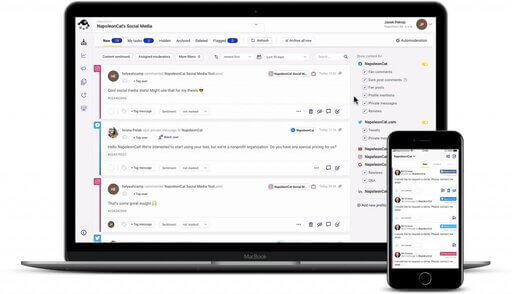
Automate brand sentiment analysis on social
Use NapoleonCat to automatically analyze and label the sentiment of all your social media interactions—powered by an advanced AI engine.
What is brand sentiment analysis?
When people talk about your brand online in reviews, comments, or social media messages, what they say usually reveals not just what they think but also how they feel. That “how” is essentially brand sentiment analysis. It’s the process of analyzing customer conversations and assigning them a sentiment tag: positive, negative, or neutral.
It’s like an additional layer of information, way beyond just counting brand mentions or comments. Sentiment analysis uncovers customer emotions that contribute to loyalty, churn, or advocacy. For social media managers, marketers, and customer service teams, it’s an important indicator to understand the tone of online conversations and act on them more effectively.
Why modern businesses should care about brand sentiment
Because it’s what makes a difference between a good and a bad brand reputation. Structured social sentiment analysis is what helps brands make decisions based on actual customer emotions rather than your marketing team’s assumptions and the famous “marketing gut”.
Tracking brand sentiment on social media is nothing new – it’s just that we have better, more accurate tools to do that now (I’ll show you some of them in a minute or two). And it’s important because customer perception can change pretty quickly, affecting your business. A single viral complaint can affect your reputation, and a wave of positive comments can drive new sales.
But to be able to respond in a relevant way, you need to monitor the sentiment closely and seize the opportunities as they come. And there’s lots – brand sentiment analysis helps with:
- Reputation management – spotting negative sentiment early lets you respond before issues escalate.
- Discovering customer experience insights – sentiment trends reveal pain points, satisfaction levels, and expectations.
- Marketing optimization – positive sentiment can guide you towards what resonates in your campaigns (and negative to what doesn’t).
- Competitive advantage – monitoring sentiment around your brand (and your competitors) shows where you stand in your industry.
Let’s talk about the tools that make all of the above much easier.

Automate brand sentiment analysis on social
Use NapoleonCat to automatically analyze and label the sentiment of all your social media interactions—powered by an advanced AI engine.
The role of AI in brand sentiment: Introducing NapoleonCat’s AI Assistant
In the old days, brand sentiment analysis used to be a manual-heavy process: going through messages, reviews, survey results, and comments one by one, trying to assign a label. I don’t have to tell you that this was not scalable, and naturally, automation and later AI became handy to make the process more efficient.
And that’s exactly what NapoleonCat’s AI Assistant does. It’s built directly into the Social Inbox, automatically analyzing each incoming comment, message, or review and tagging it with the appropriate sentiment: positive, neutral, or negative (which you can also assign manually if you want to). And yes, it can easily identify sarcasm, too 😉

You don’t have to rely on just your gut feeling or spend hours tagging messages manually. Instead, you get an instant, AI-powered understanding of how people feel about your brand, all happening in real time.
To use the AI Assistant, all you need to do is turn it on in the Social Inbox for the social media accounts you want it to work for. In addition to brand sentiment, it can also automatically detect spam and hate speech and tag it in the inbox.
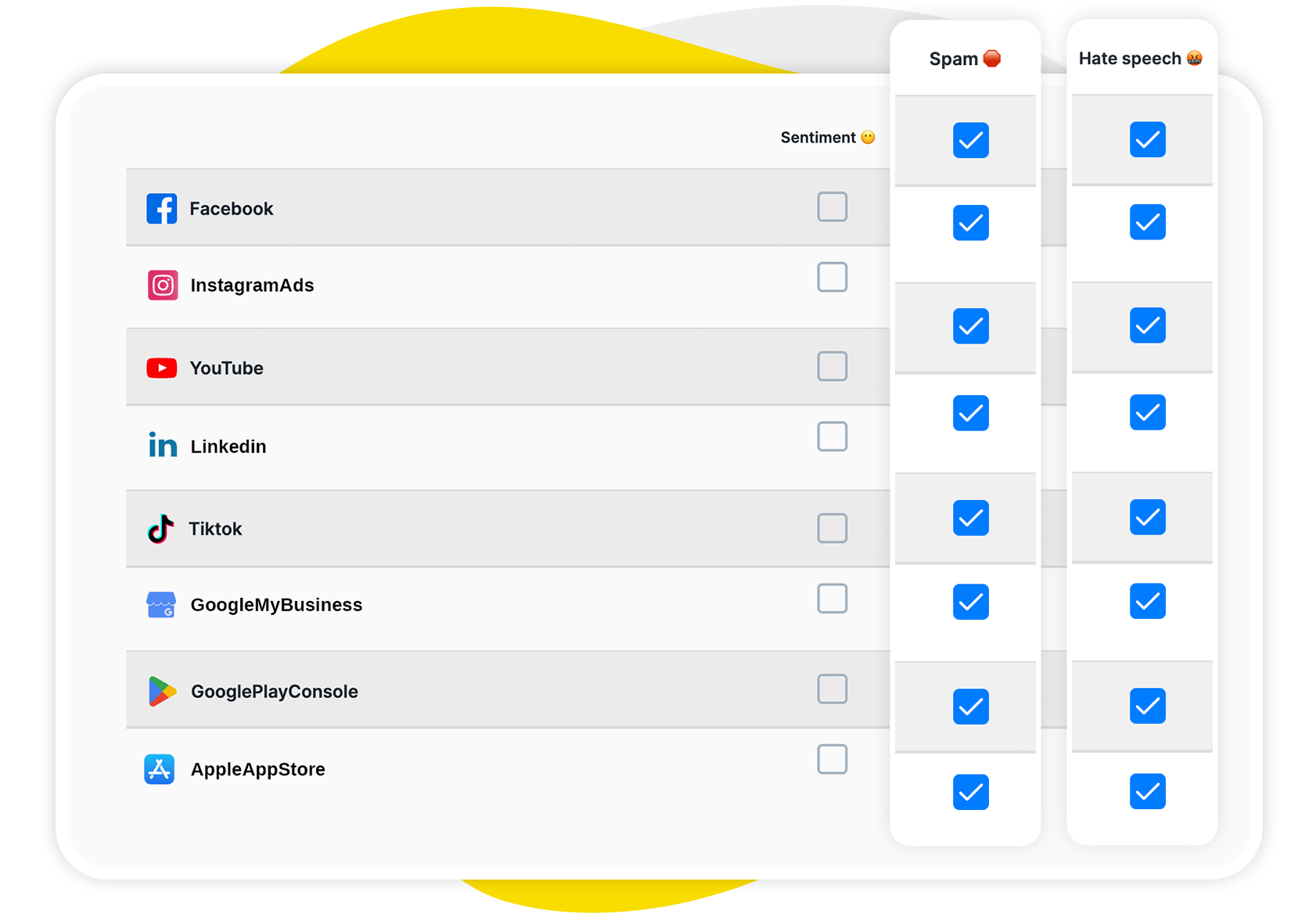
Automatically tagging sentiment: positive, neutral, negative
Let’s focus on the automated sentiment tagging, though. The AI Assistant evaluates every incoming interaction (like a DM or a comment) and applies a sentiment label:
- Positive for praise, appreciation, and satisfied feedback.
- Neutral for informational or factual messages without clear emotions.
- Negative for complaints, frustrations, or dissatisfaction expressed by your customers.
By consistently tagging sentiment, you can:
- Prioritize urgent cases, escalate and resolve them quickly.
- Celebrate wins and positive feedback (and report it to your clients 🥳)
- Spot trends and opportunities for product or service improvement.
Without guesswork, hours spent manually tagging messages, or inconsistent results (because, let’s not forget, humans interpret tone differently, while AI’s interpretations are based on tons and tons of data and continuous training for accuracy).
Inbox Analytics: visualizing sentiment trends and breakdowns
Tagging messages is step one. Step two is seeing the bigger picture and deciding what to do about it (well, deciding what to do is already step three). For the bigger picture, trends, and opportunities over time, you’ll need Inbox Analytics.
The sentiment tags feed into analytics dashboards in NapoleonCat, letting you:
- Track your positive vs. negative ratio over time.
- Spot sudden spikes in sentiment (maybe after a product launch or a PR issue).
- Break it down by social media account and timeframe.
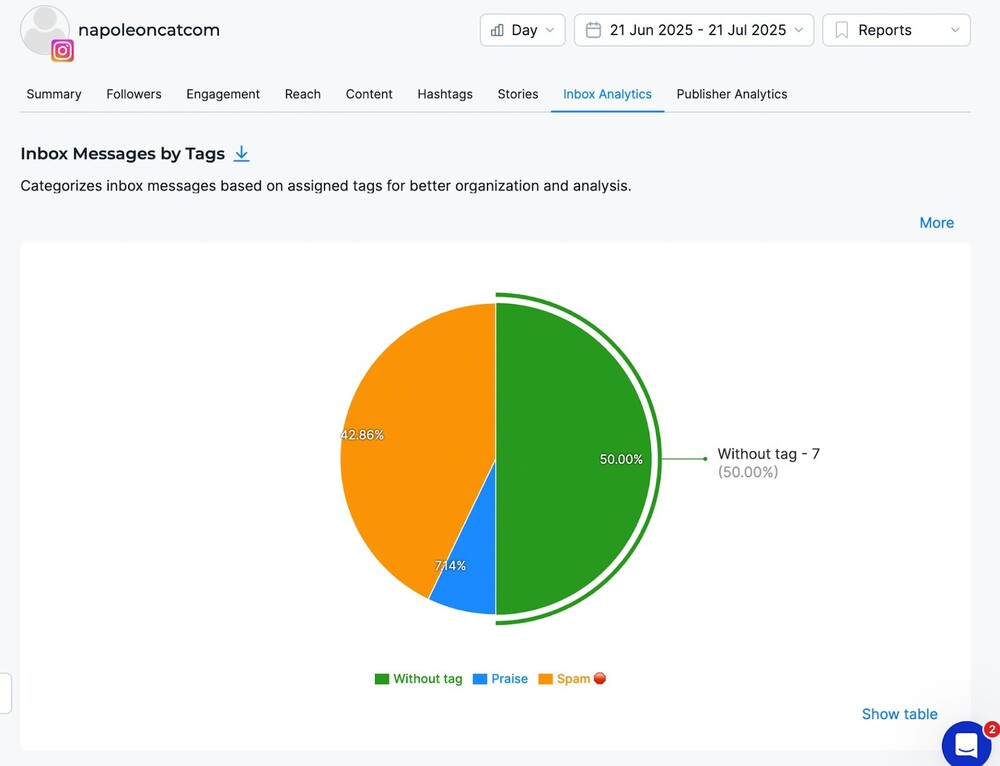
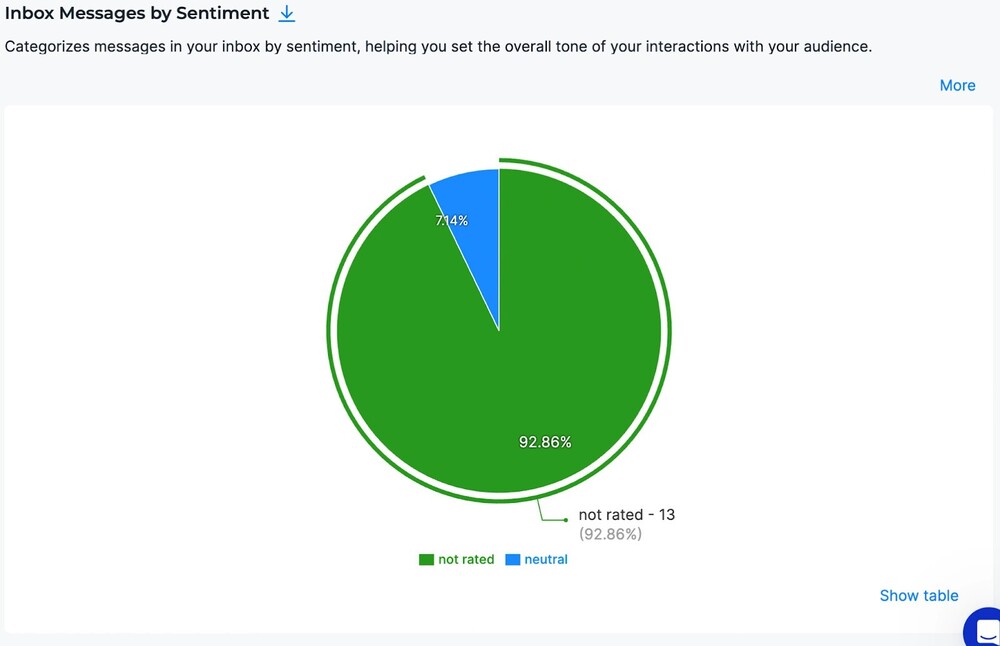
So now, instead of drowning in individual messages, you get a clear, visual story of how people perceive your brand. (It’s almost like having a sentiment “thermometer” for your brand. 🌡️)

Automatically Block Spam with AI Precision
Automatically hide or delete spam and hate comments on your posts and ads across all your social media profiles, powered by advanced AI.
Auto-moderation actions based on sentiment tags
And that’s not it yet. You can couple automated sentiment analysis with Auto-moderation in NapoleonCat. Once the AI Assistant tags a message or comment, it can automatically trigger actions. For example:
- A negative comment can be automatically flagged in NapoleonCat for your support manager or assigned to a specific team member.
- A positive review can trigger an automatic thank-you reply or get tagged for your marketing team to showcase as social proof on social media or your website.
- Neutral inquiries can be routed straight to customer service for quick answers.
This way, sentiment analysis becomes a real-time workflow that helps you handle conversations faster while still keeping things relevant, helpful, and accurate.
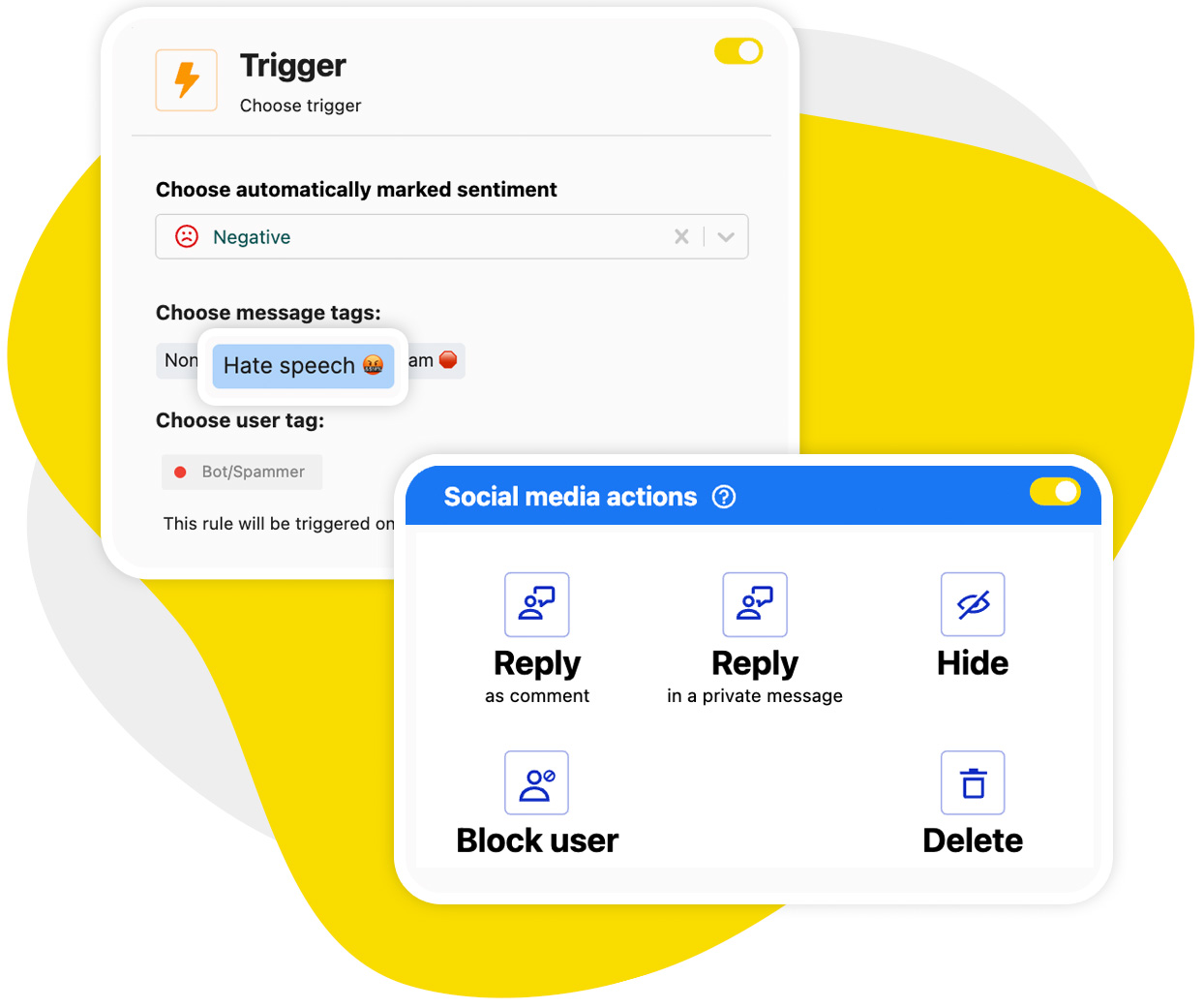
Workflow: from incoming message to auto-action in Social Inbox
So how does all of this actually work when you’re sitting at your desk (or, on your phone with a coffee in hand) managing customer conversations? Let’s walk through it step by step.
1. A message comes in
A customer leaves a comment on your Instagram post, sends you a Facebook DM, writes a Google review, or asks a question under your YouTube video. It lands in your Social Inbox, where you can see and manage all your interactions in one place.
2. AI Assistant tags the sentiment
As soon as that message arrives, NapoleonCat’s AI Assistant analyzes the text and automatically assigns it a sentiment tag: positive, neutral, or negative. This happens instantly, so before you even click on it, you already know the tone.
- A customer writes, “Love your new product, it’s exactly what I needed!” – tagged as positive (obvs).
- Another says, “Still haven’t received my order. Not impressed.” – tagged as negative.
- And “What’s the price of this?” – neutral.
3. Auto-moderation picks up
Based on the sentiment tag, your Auto-moderation rules take over. You decide in advance how you want different types of messages to be handled – and create relevant Auto-moderation rules first. For example:
- Negative sentiment → Assign to a senior support agent and respond with a relevant direct message about the problem being handled.
- Positive sentiment → Trigger an automatic thank-you reply and tag the message for your marketing team as praise.
- Neutral sentiment → Route it straight to customer service for a quick, factual response (or reply automatically based on relevant FAQ-related keywords).
4. You (and your team) respond
With the message already categorized and routed, the right person can step in quickly. This keeps response times nice and short while customers still get relevant answers.
5. Inbox Analytics tracks it all
All those interactions, along with their sentiment tags, feed into Inbox Analytics. You can see how many positive vs. negative messages you’ve handled, what your team’s response times look like, and whether your sentiment balance is improving over time.
Best practices for using sentiment analysis in review and message management
AI-powered sentiment tagging and Auto-moderation can save you literal hours every week. But like any tool, you’ll get the best results if you set it up thoughtfully and keep fine-tuning it as you go. Here are some best practices to help you make the most of NapoleonCat’s brand sentiment analysis features:
1. Set up clear Auto-moderation rules
Figure out first what should happen when a message gets tagged as positive, negative, or neutral. Consider the way your business works and the most common scenarios that happen with customers and social media followers. Here are a few more examples:
- Negative → escalate to a senior agent or trigger a personal follow-up.
- Positive → send an instant thank-you and add a “happy customer” tag for testimonials.
- Neutral → route to your FAQ team or set a quick response based on keywords.
2. Combine numbers with what’s in the conversations
Looking at your Inbox analytics will help you spot trends, but don’t forget to dip into individual messages, too. For instance:
- If 20% of your comments are negative, look at what customers are actually saying. Is it about delivery times? Product quality? Customer service? Note down the reasons and see what you can do to improve.
- Look into your positive comments for recurring themes and phrases you can use in your marketing offers. Voice of customer research is a goldmine of effective marketing copy for your website or email campaigns. Effective, because you talk in your customers’ words, and they can relate to what you’re saying.
3. Highlight the positives
Those happy comments shouldn’t be confined just to your inbox. Positive sentiment is a marketing asset. Here’s how you can use it:
- Share glowing reviews on your social channels (with customer permission).
- Highlight them in newsletters.
- Show them in team meetings to remind everyone why their work matters.
4. Track sentiment over time (not just day to day)
A single spike in negativity might just mean someone had a bad Monday. (Honestly, I don’t blame them.)
What matters is the overall trend. Are positive comments growing after your new product launch? Are negative reviews dropping since you changed suppliers?
With Inbox Analytics, you can track changes and see the long-term impact of your efforts.
5. Connect sentiment analysis to business goals
Link your sentiment insights to your bigger picture KPIs and your growth strategy. Improving your positive sentiment ratio could become a quarterly goal, and reducing negative reviews might tie directly into improving customer satisfaction scores.
Spotting neutral FAQs could also help reduce support load by improving your self-service resources.
Automate brand sentiment analysis off your plate
Brand sentiment analysis doesn’t have to be complicated, manual, or something you only do “when there’s time.” With NapoleonCat’s AI Assistant, Auto-moderation, and Inbox Analytics, you can track how people feel about your brand in real time, act on it automatically, and use the insights to grow.
Give your team a break from inbox overload—let AI do the heavy lifting. Try NapoleonCat completely for free for 14 days. You won’t want to go back 🙂

Automate brand sentiment analysis on social
Use NapoleonCat to automatically analyze and label the sentiment of all your social media interactions—powered by an advanced AI engine.
Brand sentiment analysis – FAQs
Find quick answers to the most common questions about brand sentiment analysis and how it works.
What is a good example of brand sentiment analysis?
Say you launch a new product. Using NapoleonCat, you track reviews and social comments. The AI Assistant tags each one, and Inbox Analytics shows: 70% positive, 20% neutral, 10% negative. You notice the negative ones are mostly about delivery delays.
Now you can fix logistics while celebrating the positive feedback in your marketing.
What are the four main steps of sentiment analysis?
- Collect customer data, for example, in your Social Inbox in NapoleonCat (reviews, comments, DMs).
- Process your data (with NapoleonCat, you don’t have to worry about that step – it happens behind the scenes)
- Detect sentiment (positive, neutral, negative). With the AI Assistant, it can also happen automatically.
- Analyze results – trends, ratios, spikes, etc. With the Inbox Analytics, you can see them visualized, making analysis and action planning even easier.
Is brand sentiment a KPI?
It can be if formulated in a way that’s specific enough and measurable. For example, you might set a goal to keep positive sentiment above 70% or reduce negative mentions by 20% in a quarter.
What is a good brand sentiment score?
It depends on your industry, but generally, a majority positive sentiment (60–70% or higher, depending on how you calculate it) is a healthy sign. The key is watching changes over time and setting improvement goals on a regular basis.
You may also like:
- Best Content Moderation Tools to Protect Your Brand Online
- All-in-One Social Inbox: Reply to Everything in One Place
- Team Inbox for Social Media: Everything in One View
- Unified Inbox for Social Media: One View, All Messages
- Pre-Customer Service on Social Media: Insights & Tips
- Master Post-Purchase Customer Support on Social Media
- How to Manage All Social Media in One Place – Facebook, TikTok, Instagram, and more
- Social Media Comment Management: Full Expert Guide
- Support Your Team With a Social Media Moderation Tool They Deserve
- Multi-Account Social Media Management: Full Guide
- Online Reputation Management 101 for Brands
- Your Guide to Social Media Comment Moderation
- Outbound Engagement – Expert Guide
- AI vs Human Responses on Social Media: Facts & Figures





